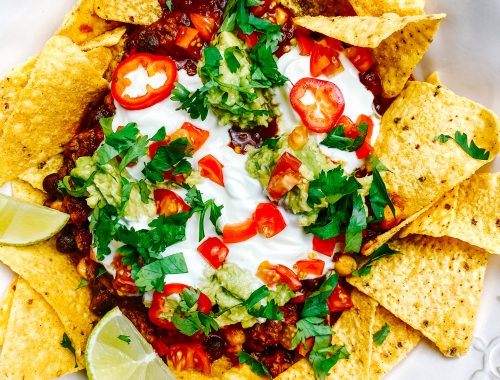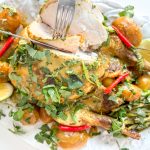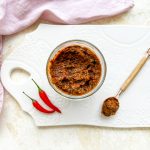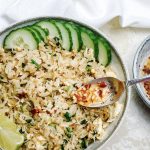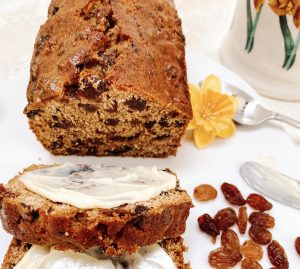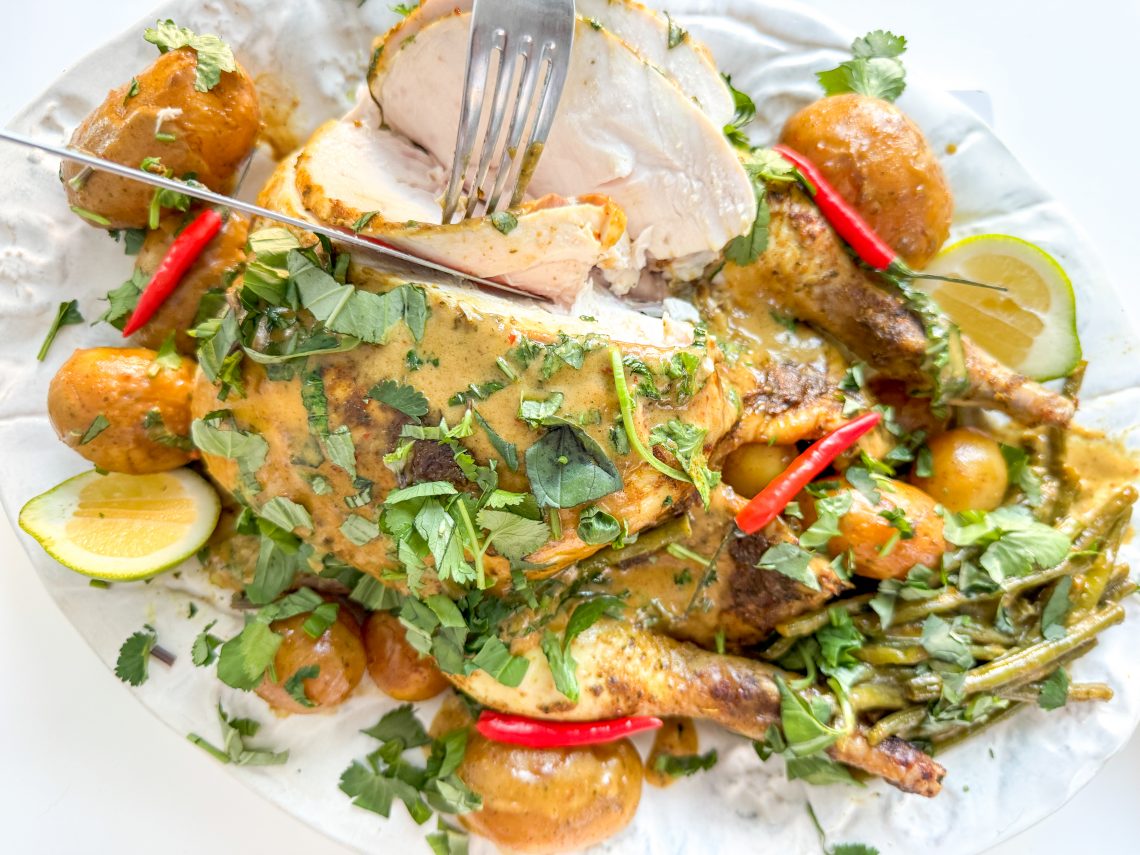
One-pot Thai Roast Chicken, New Potatoes and Green Beans with a Red Curry and Peanut Gravy
This wonderful one-pot Thai roast chicken recipe is the lovechild of Thai Red Chicken Curry and Satay Chicken with Peanut Sauce; two of our absolute favourite suppers. Having made Wadadli Spiced Roast Chicken and Coconut Gravy a few times recently, we were craving something similar but with a different flavour profile. We were looking for tender, melt-in-mouth roast chicken with Thai flavours, a significant kick, cooked in one-pot with vegetables and a thick, rich spicy gravy. Turns out, this dish really, really hit the spot.
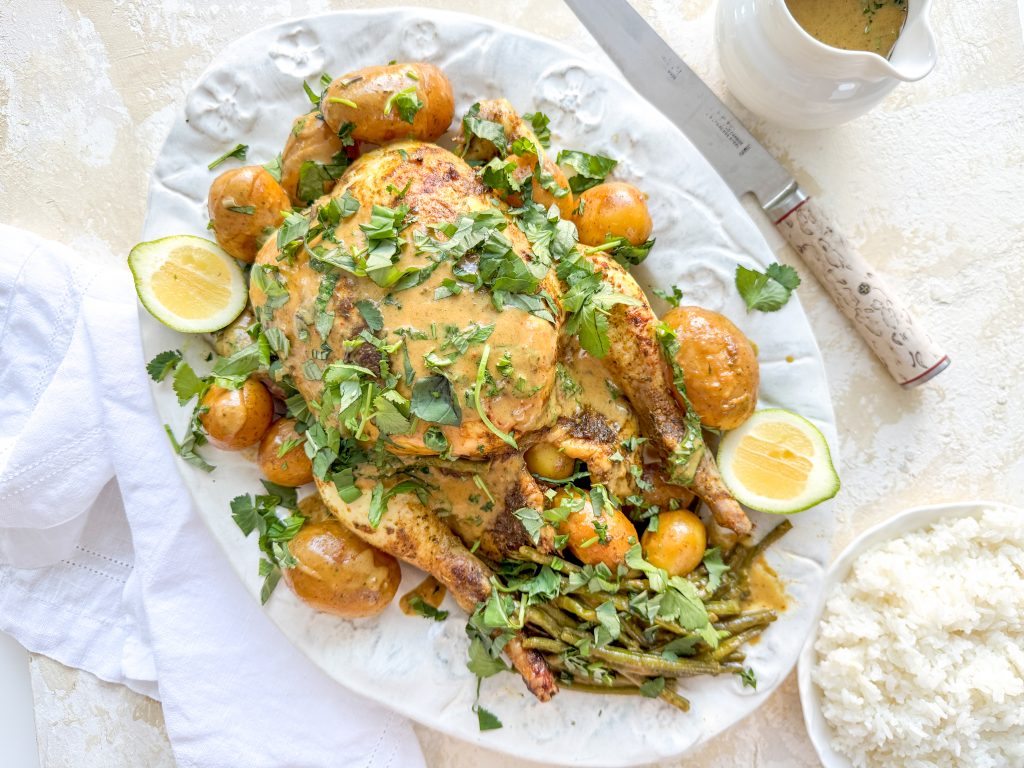
To make it, you simply slather a whole chicken in quick-to-make spicy marinade, (very similar to the one I use when making Chicken Satay with Peanut Sauce) and it is then roasted with the potatoes, green beans and some stock. The gravy is a real flavour bomb – to make it, all you need to do is remove the chicken from the pan and mix the red curry sauce ingredients with all the incredible juices already in the pan and simmer gently for around 10 minutes. This will reduce the gravy slightly and allow all the wonderful flavours to merge and develop. Scatter over more fresh herbs, serve some rice and a few wedges of lime alongside, and this meal is ready to go.
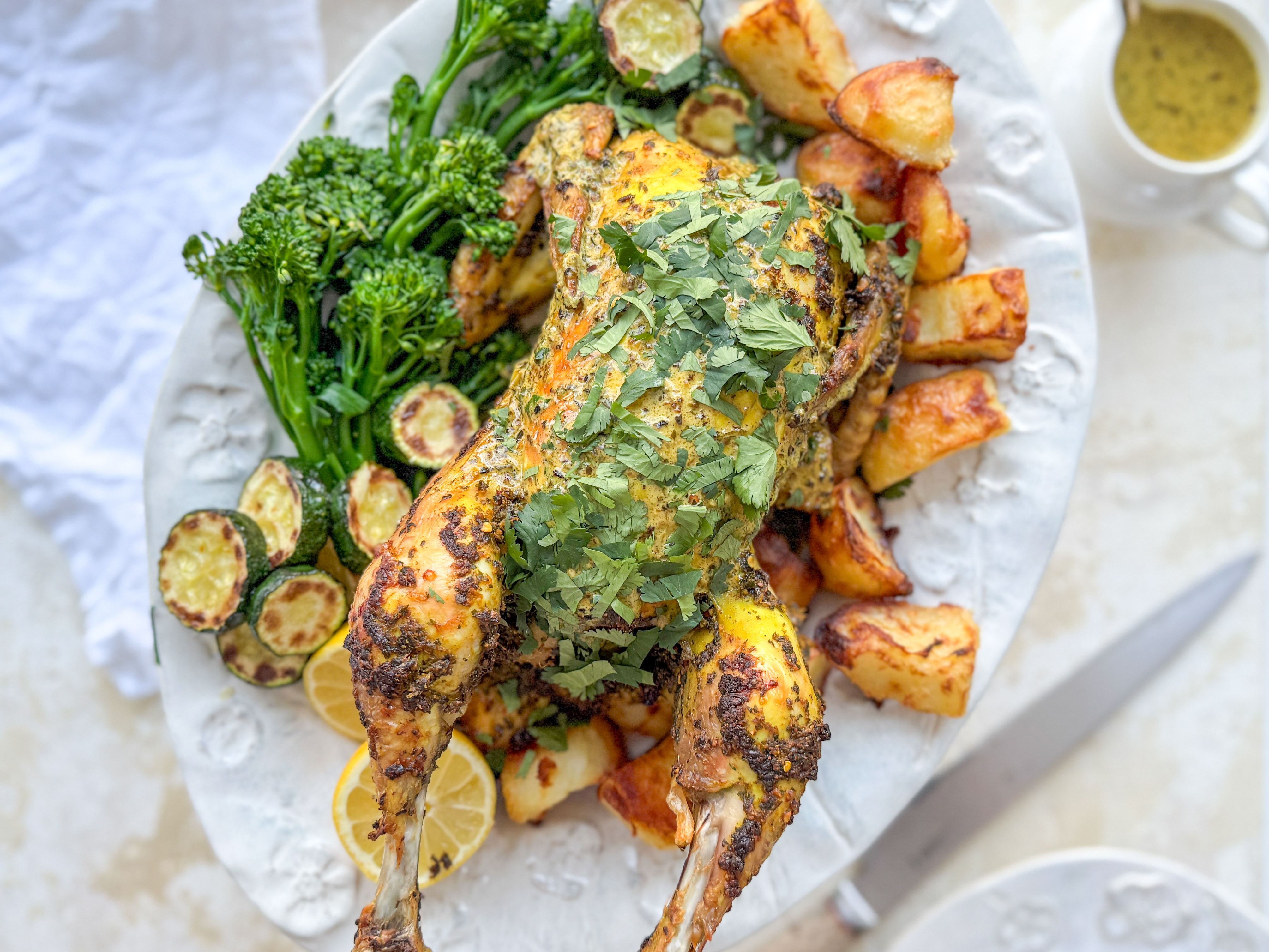
Wadadli 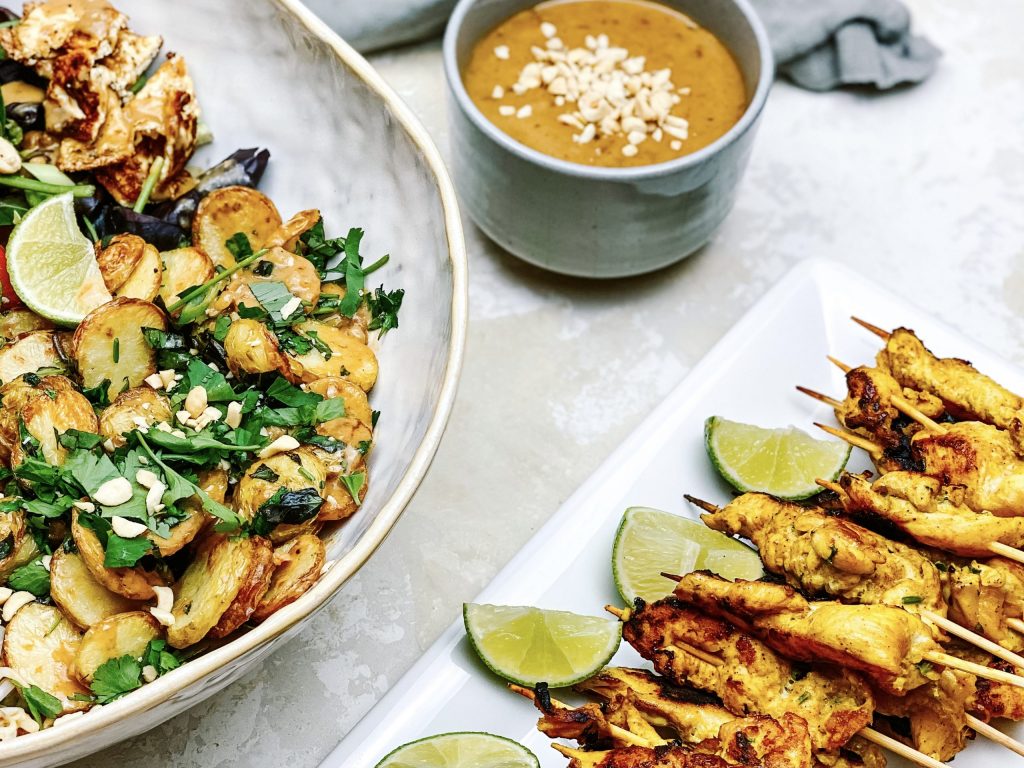
Satay 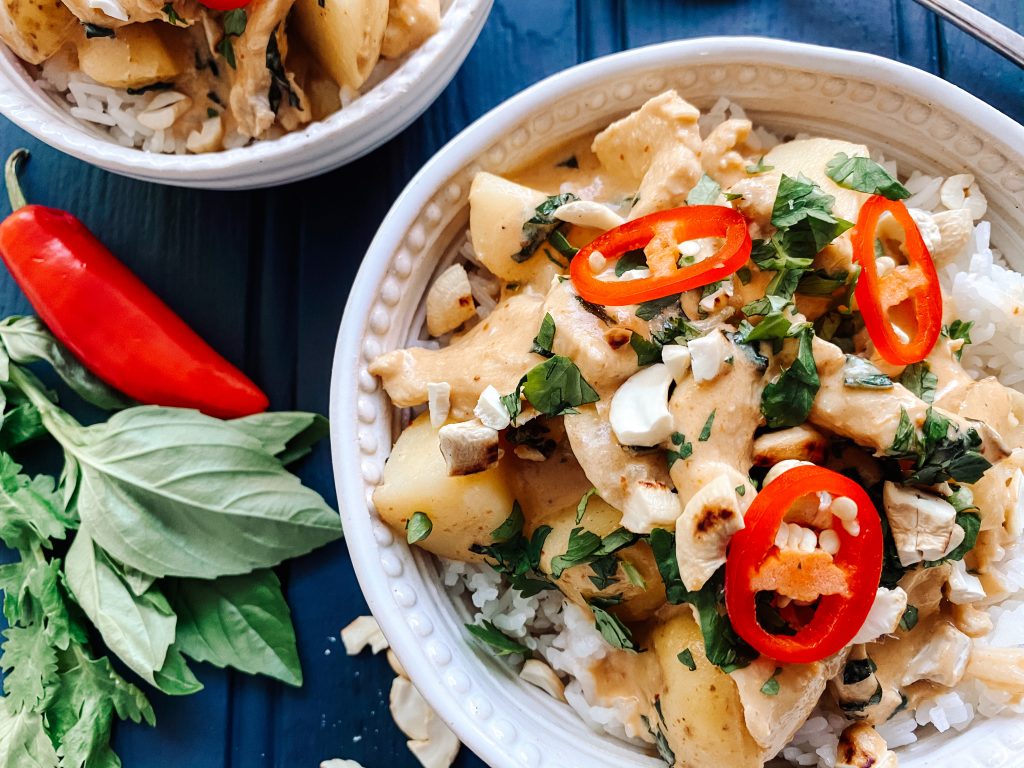
Red curry
How to make Whole Thai Chicken, Roast New Potatoes and Green Beans with a Red Curry Gravy
Please don’t be put off by the long list of ingredients, many are duplicated in the marinade and the gravy, most are readily available and, in fact, the whole dish comes together remarkably quickly and easily.
Collect together all your ingredients:
Chicken:
- whole chicken. Ideally organic.
- plump cloves of garlic, bashed. No need to peel.
- kaffir lime leaves. These can be difficult to find so I buy frozen ones from my local Asian shop. They freeze very well and can be used directly from the freezer.
- lemon grass, trimmed, cut into 3 or 4 pieces and bashed. Lemon grass is now readily available in most large supermarkets and is usually near the herbs, garlic, ginger and chillies.
- fresh coriander
- fresh Thai basil, if you can find some. If not, simply omit.
- coconut oil. Or you could use any other neutral oil.
- new potatoes. Skin on and halved or cut into 3 or 4 pieces, if large.
- chicken stock. Either homemade or shop bought.
- green beans, trimmed
Marinade:
- fresh coriander, including stalks
- Thai basil, including stalks, if you can find some. If not, double up on the coriander or you could use a little fresh tarragon as this will add the lovely aniseed flavour to the marinade.
- plump cloves of garlic, peeled
- Thai red curry paste, either homemade or shop bought. If buying, I get it from my local supermarket but you can get it on line too. My favourites are Maesri or Mae Ploy.
- curry powder. Curry powder from your local supermarket will be fine.
- palm sugar (or coconut, soft brown or caster sugar). I buy palm sugar which is sold in large crystals. It is often sold is thick chunks which can be grated, hence I have given the quantity in grams as well.
- fish sauce. This is readily available in most large supermarkets, probably in the Asian section.
- good quality coconut milk. Try and buy good quality coconut milk from your Asian shop. Cheap coconut milks are often diluted and thickened, and in so doing, a lot of flavour is lost.
Sauce:
- remainder of can of coconut milk (from above)
- Thai red curry paste, either homemade or shop bought. See above for details.
- smooth peanut butter. I used Manilife peanut butter, but any natural peanut butter will be fine. I prefer smooth, but feel free to use chunky. If you don’t like/want to use peanuts, simply omit from the sauce.
- palm sugar (or coconut, soft brown or caster sugar) See above for details.
- fish sauce. See above for details.
- kaffir lime leaves. See above for details.
- Thai sweet basil leaves, roughly shredded
Serve:
- limes, in wedges
- fresh coriander and/or Thai basil to garnish
- steamed rice. Ideally Jasmine, but just use your favourite.
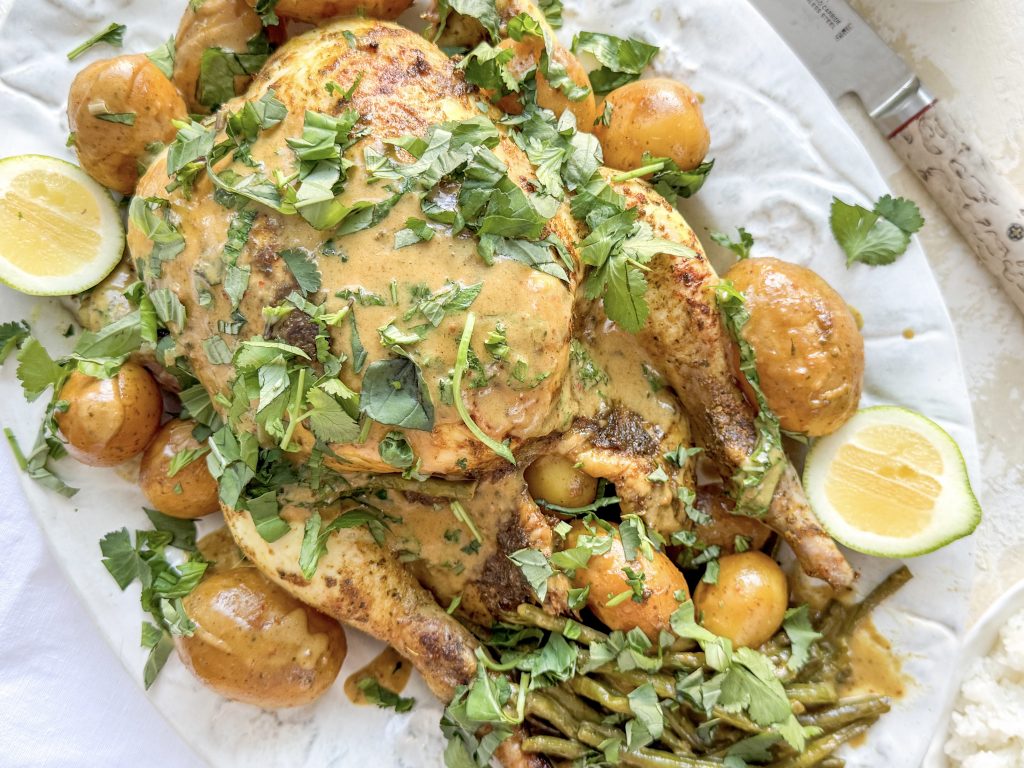
How to make this fabulous One-pot Thai Roast Chicken dish:
- Bring the chicken to room temperature. This will take between 30 minutes to an hour, depending on the ambient temperature.
- Marinade paste – blitz all the ingredients in a mini food processor until you have formed a paste. You may need to scrape down the sides of the bowl, and blitz again, to ensure even blending.
- Prepare and cook the chicken – lightly oil the base of the deep sided roasting tin with coconut oil.
- Stuff the garlic, lime leaves, bashed lemon grass, coriander and Thai basil inside the cavity of the chicken, and place into the tin.
- Rub the paste all over the outside of the chicken thoroughly, ensuring it is well coated and in all the nooks and crannies.
- Halve or quarter any large potatoes, scatter around the chicken and then pour in the chicken stock.
- Cover with kitchen foil and cook in the centre of a pre-heated oven for 1 hour.
- Remove from the oven and turn the heat up to 220°C/425°F/Gas 7 (fan 200°C).
- Remove the foil, baste the chicken and add the trimmed green beans. Return to the oven, uncovered, and continue to cook for 20 – 40 minutes, or until the chicken is cooked. To check if it is cooked, pull the leg away from the bird slightly and skewer into the breast flesh behind the leg. Any juices coming out of the bird should be clear and the meat should be opaque. If you see any pinkness or blood, cook for a further 10 – 15 minutes, or until cooked. If you use a meat thermometer, the internal temperature of the meat should read 75°C or 165°F.
- Make the red curry gravy – remove the chicken from the pan, scraping any thick areas of paste on the chicken into the pan. Allow the chicken to rest for 10 – 15 minutes before serving.
- Meanwhile, add the coconut milk to the pan with the curry paste, peanut butter, palm sugar, fish sauce and kaffir lime leaves. Bring to a gentle simmer for 7 – 10 minutes to thicken and allow the flavours to develop and merge. Stir regularly. Add any juices from the resting chicken and finally stir in the fresh herbs. There is no additional salt in this dish; fish sauce is very salty and I find it is sufficient for the dish. However, it is important to taste and adjust seasoning, if necessary.
- Serve: garnish the roast chicken, potatoes and beans with some of the red curry gravy, scatter with some chopped fresh herbs and serve with the remaining gravy. I also serve it with some steamed rice and wedges of lime on the side.
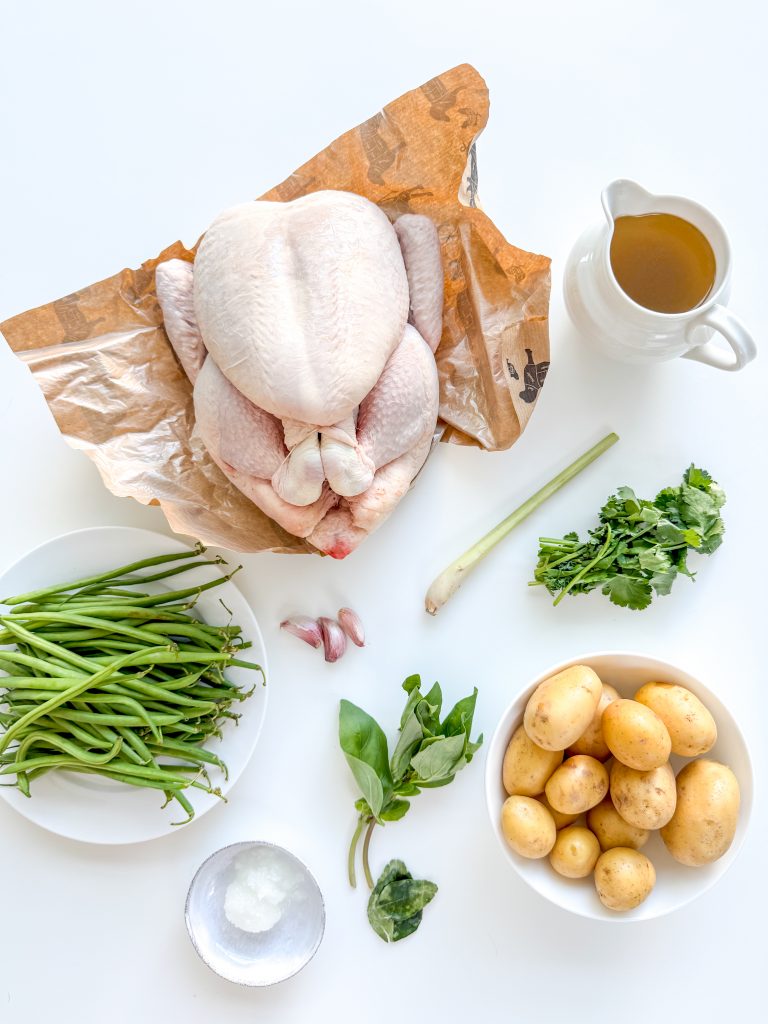
Chicken ingredients 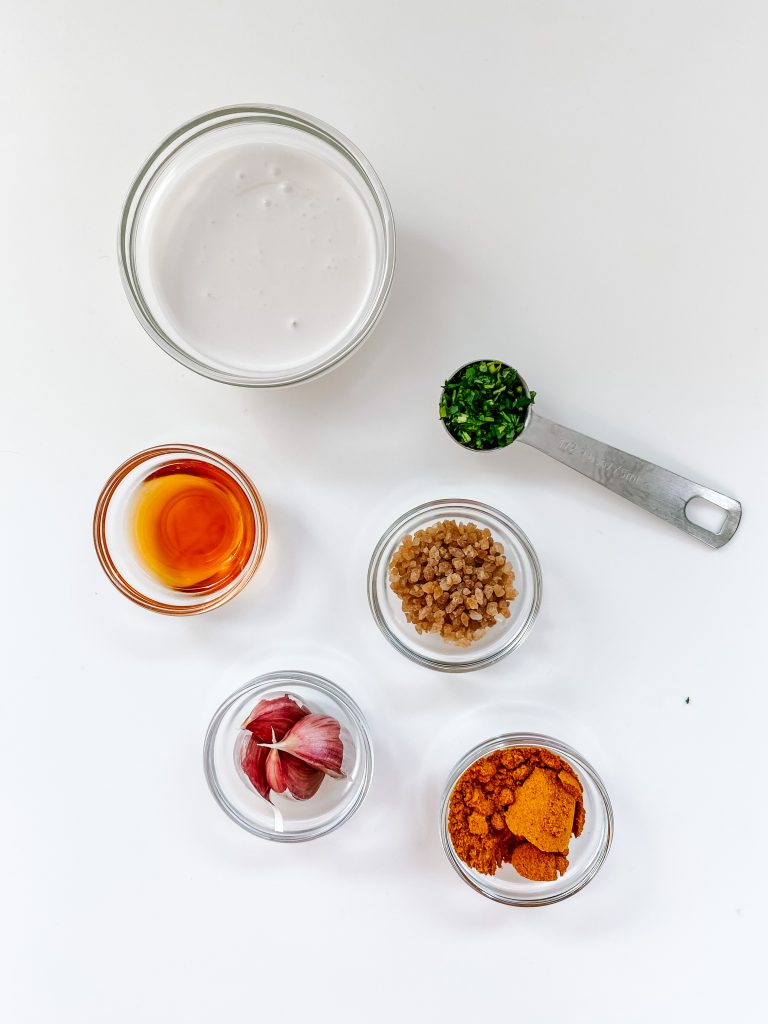
Marinade ingredients 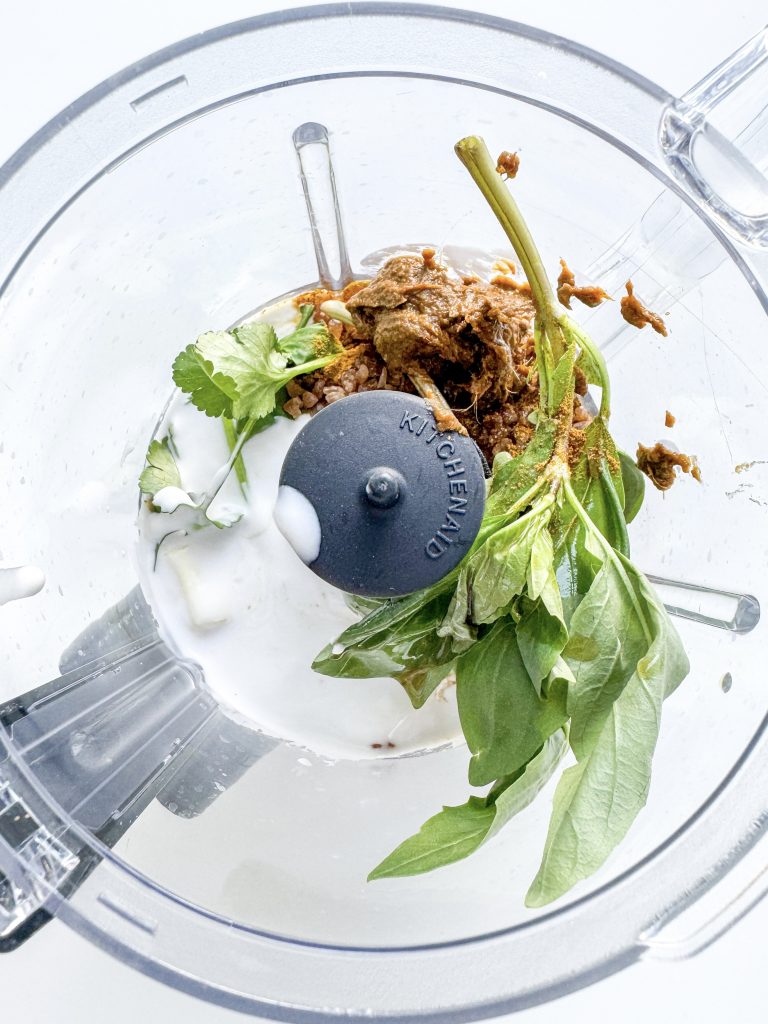
2 Blitz marinade 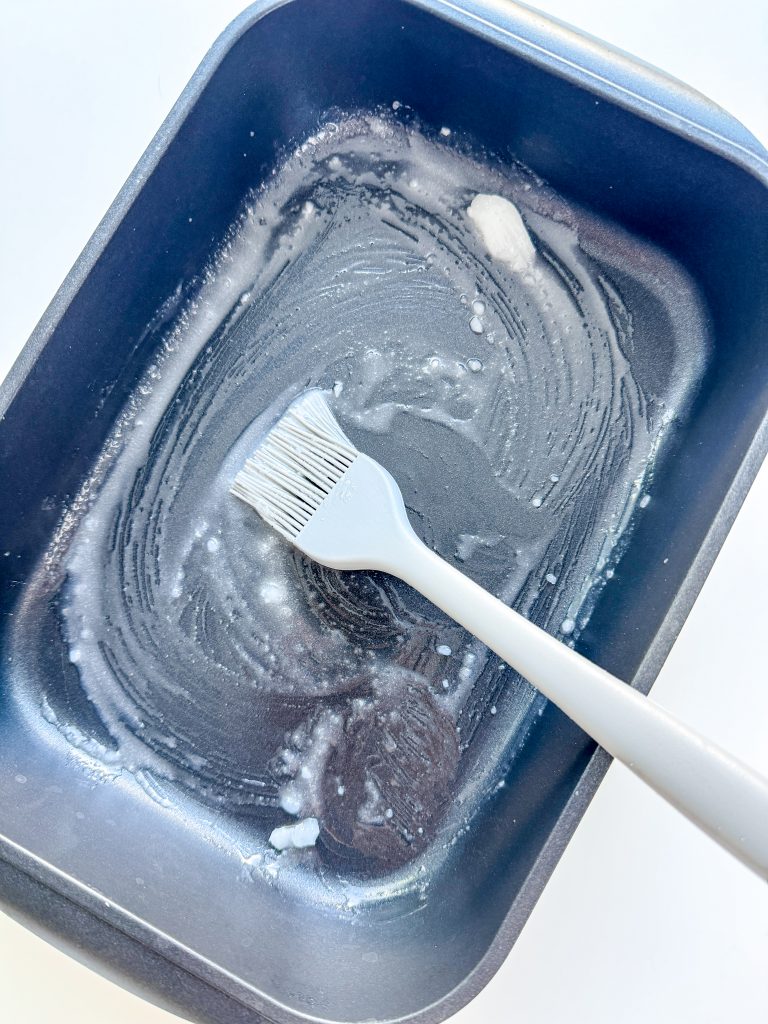
3 Oil 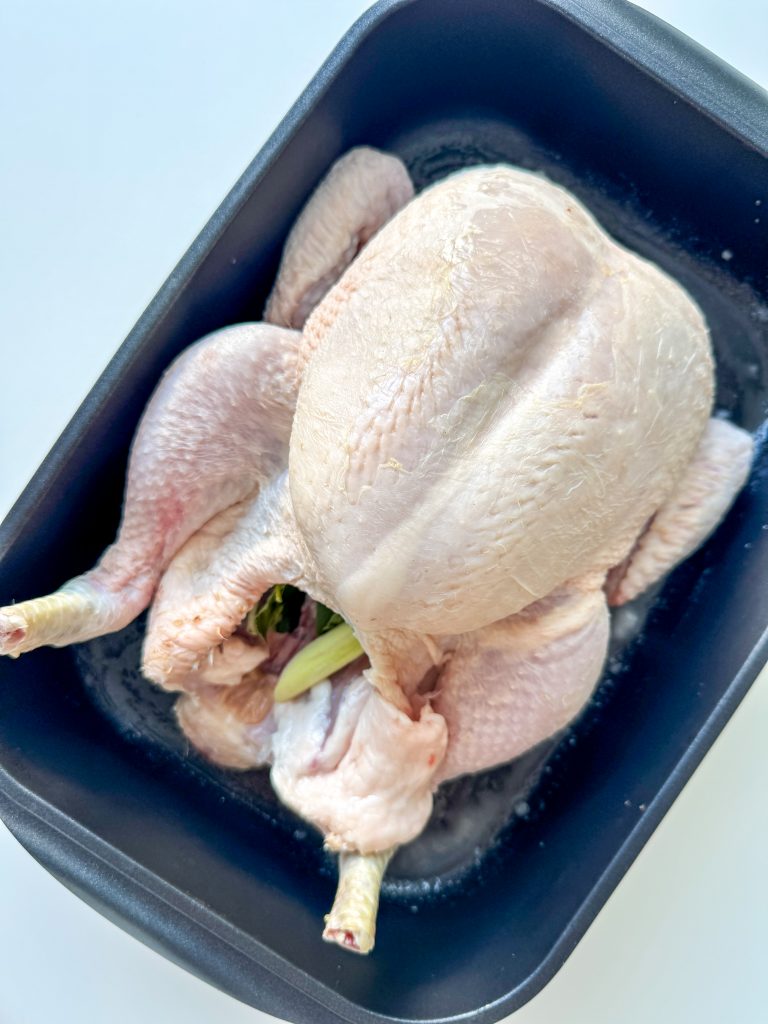
4 Stuff chicken 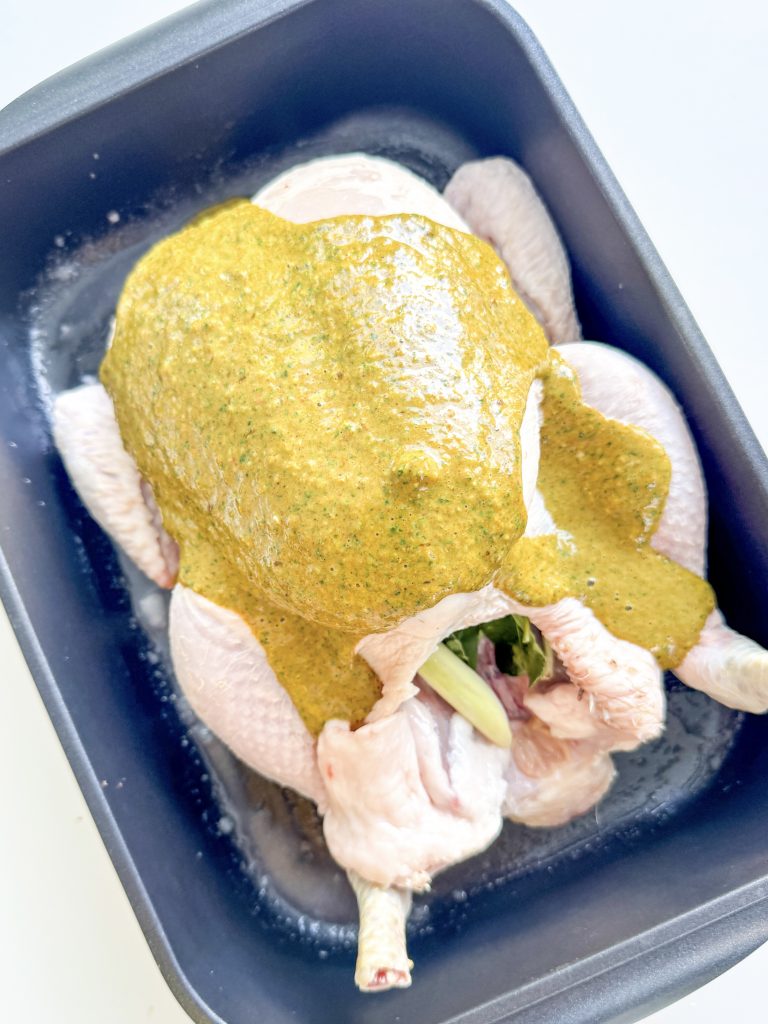
5 Cover chicken 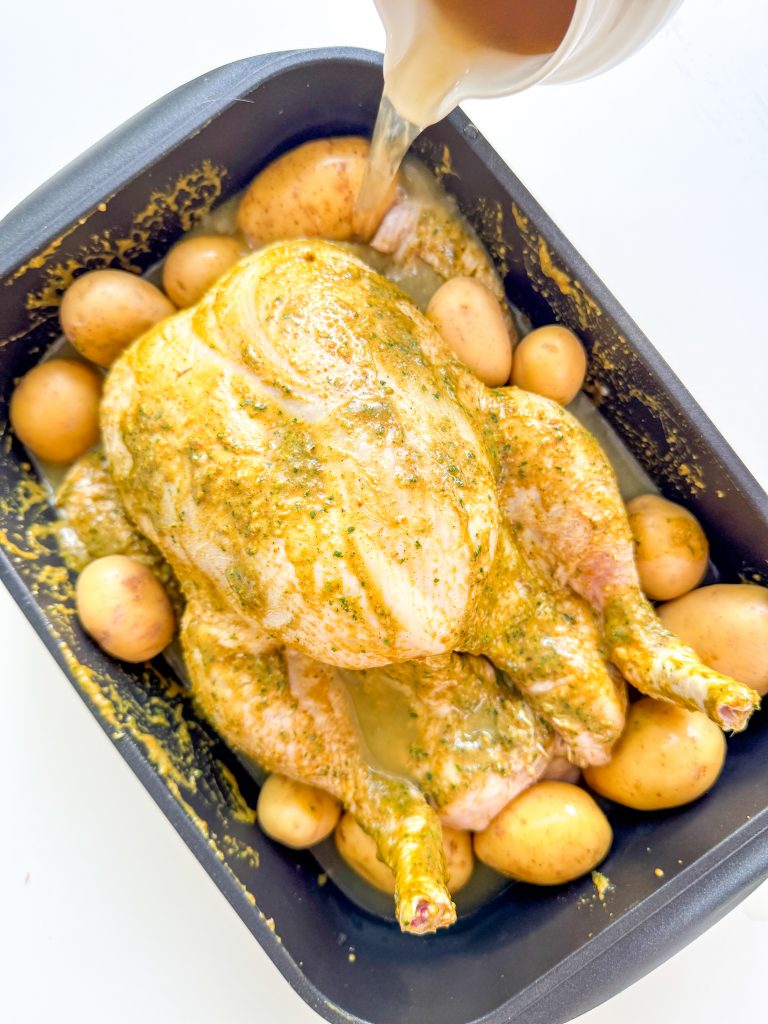
6 Pots, stock 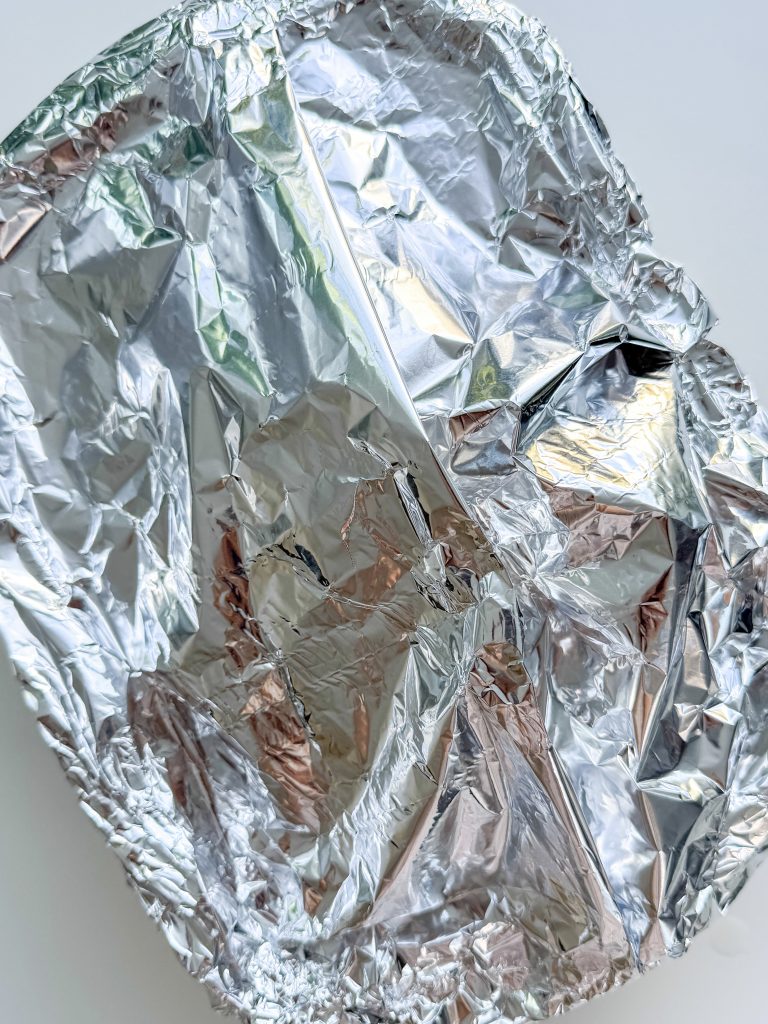
7 Oven 1 hour 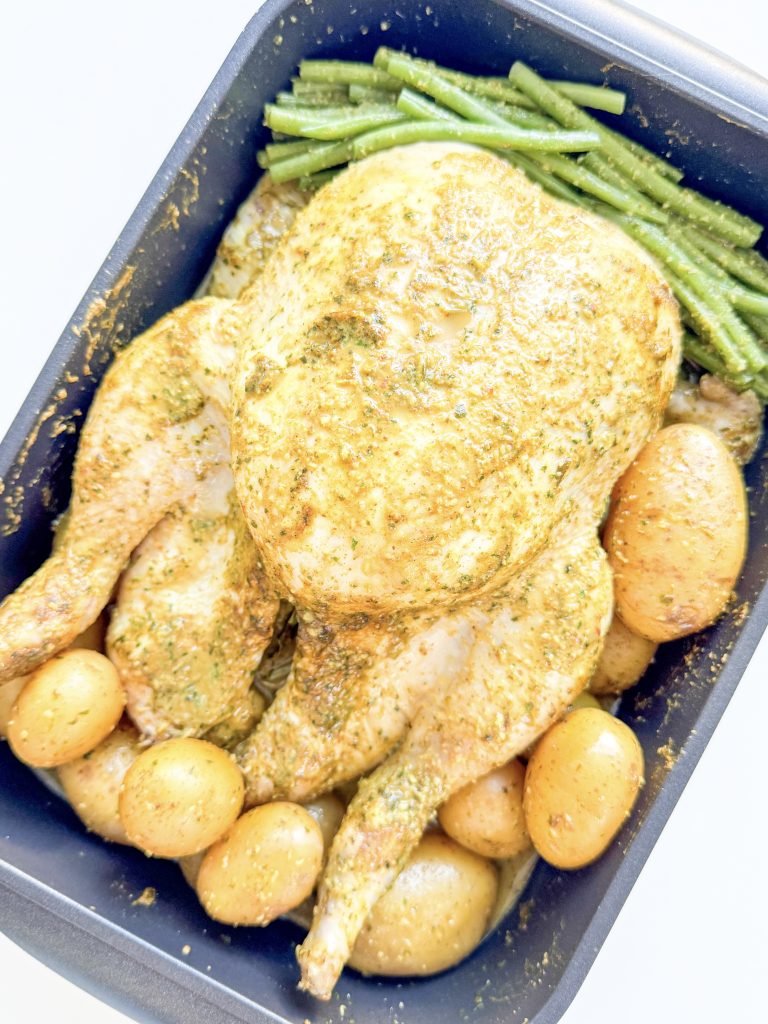
9 Baste, add beans 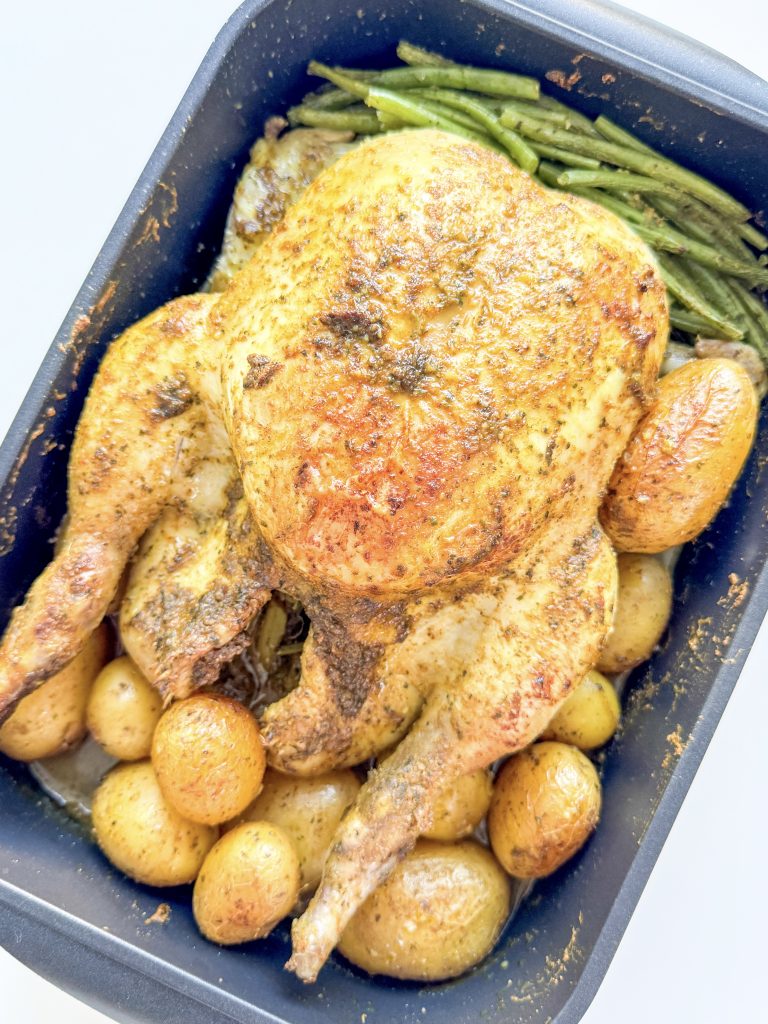
20 – 40 mins 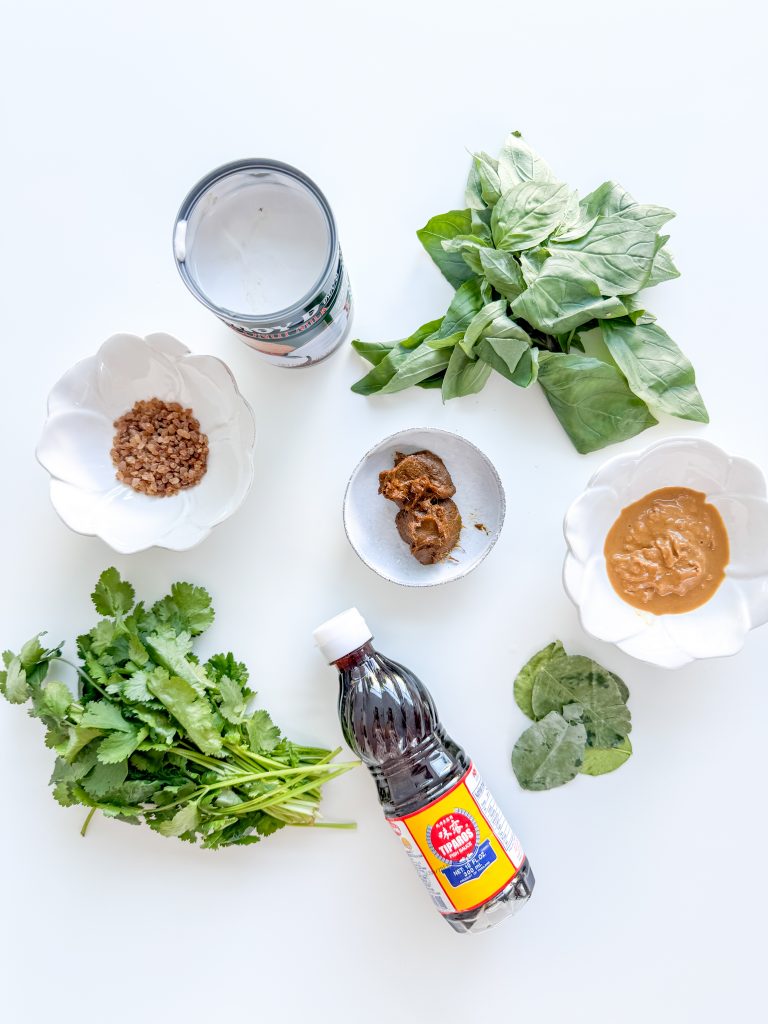
Sauce ingredients 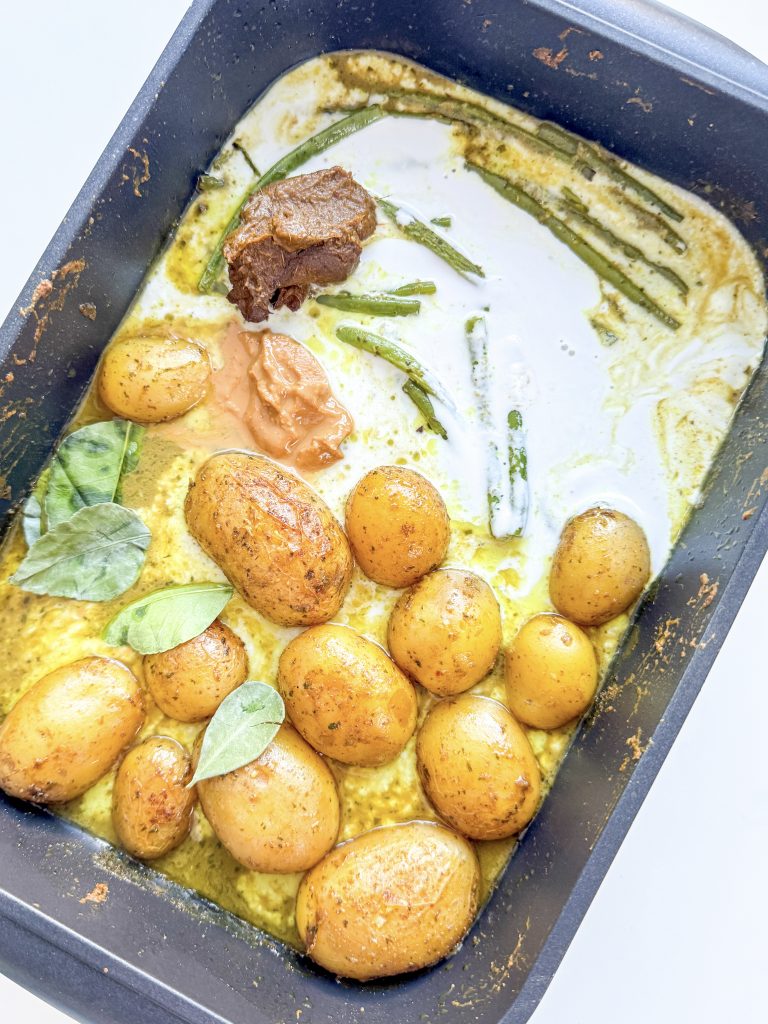
10 Make sauce 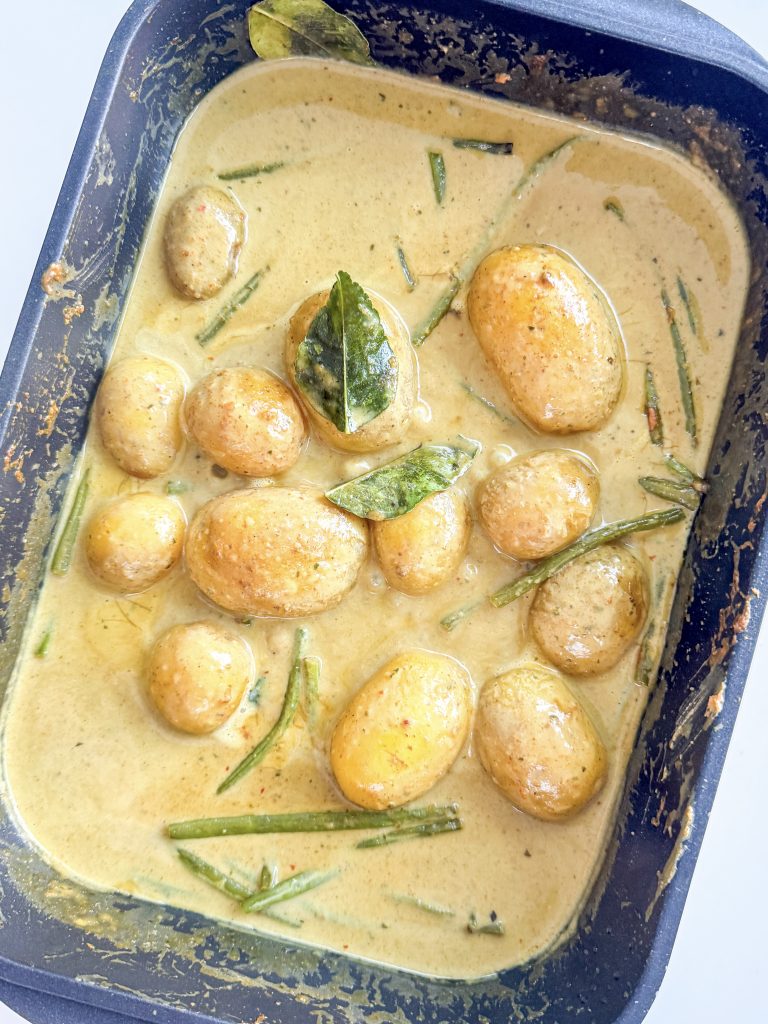
11 Cook 10 mins 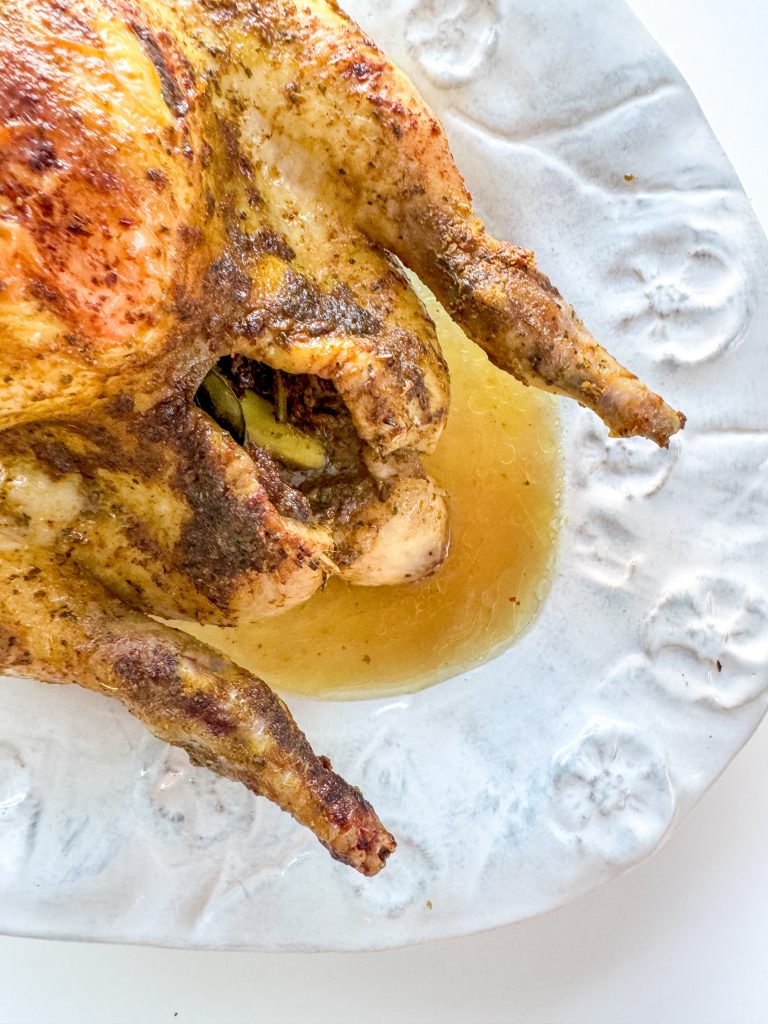
Add juices 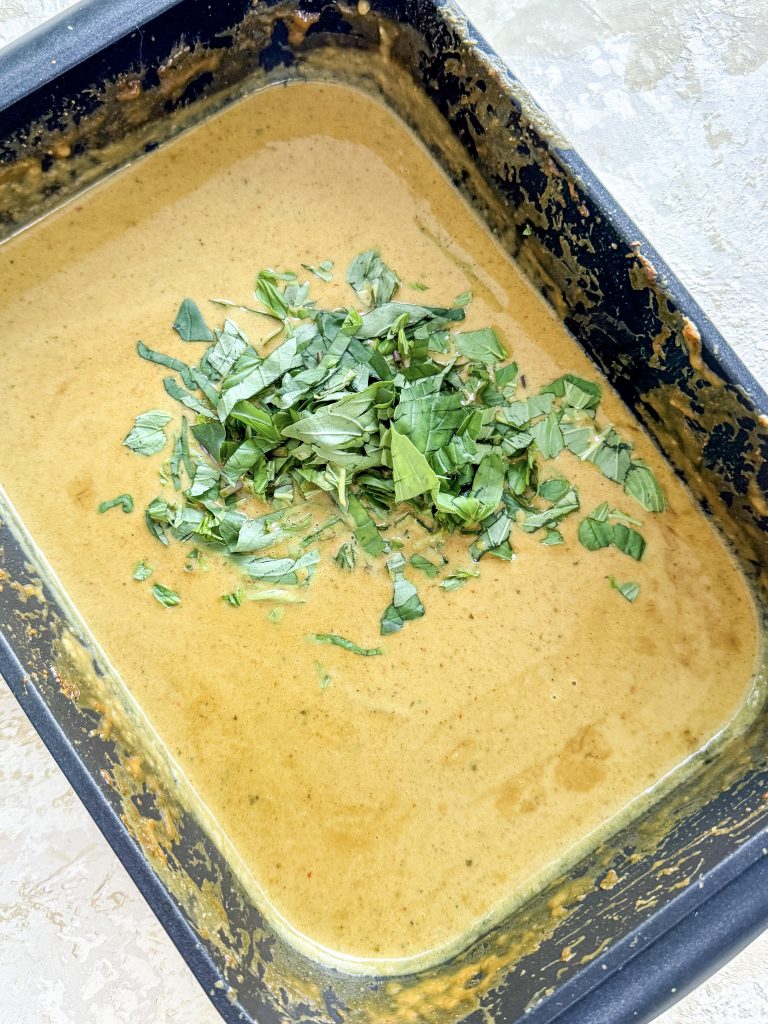
and herbs 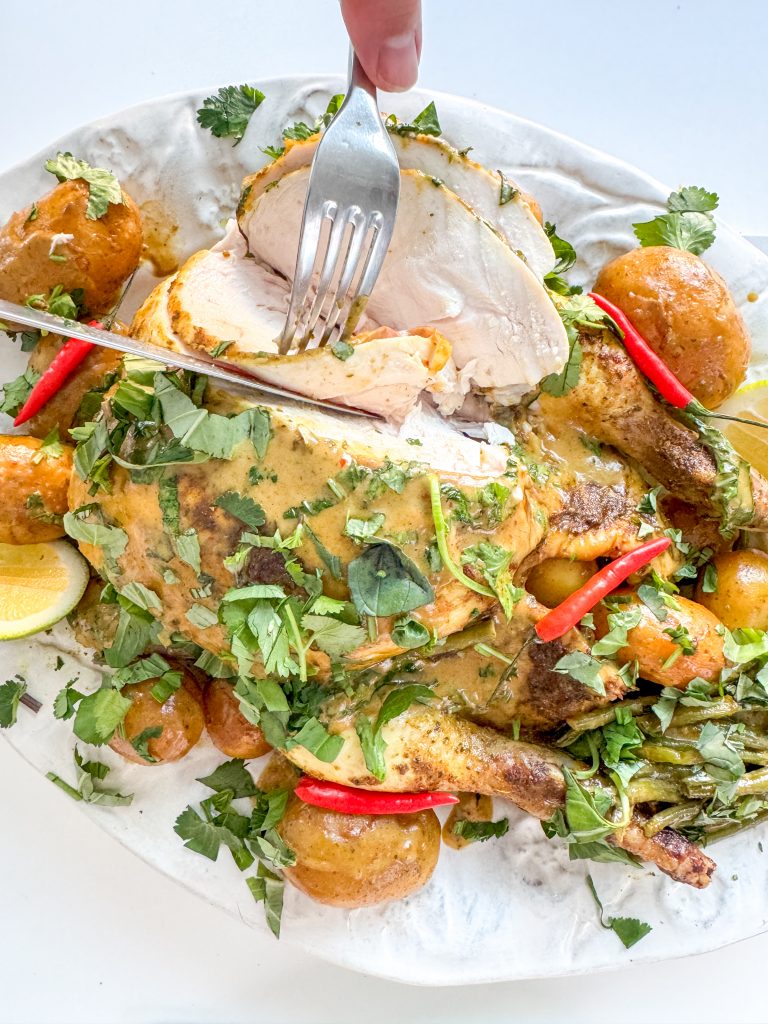
Serve
Why should meat be at room temperature when cooked?
When you cook meat, the muscles in the flesh contract and tighten when heated. The colder the muscles the more they will contract; this means it is harder for the heat to distribute evenly. By letting the meat come to room temperature before you cook it, the meat will cook more evenly and when cooked, it will be juicier. It can take between 30 – 60 minutes for fridge cold meat to reach room temperature, depending on its size and the ambient room temperature.
Why do you need time to rest the meat after cooking?
As the muscles of the meat contract and tighten when cooked, the juices are forced toward the surface of the meat and some will evaporate. (Which is why overcooked meat is dry.) Allowing the meat to rest after you have removed the heat source, means the muscles will relax and the juices can re-distribute throughout the meat. If you cut it immediately, you are in danger of losing some of these juices; your chicken may then be dry and the flavour from those gorgeous juices will be lost.
Made this recipe?
If you make this recipe, do please tag me on instagram @daffodil_kitchen. You could also leave a comment in the box directly below the recipe.
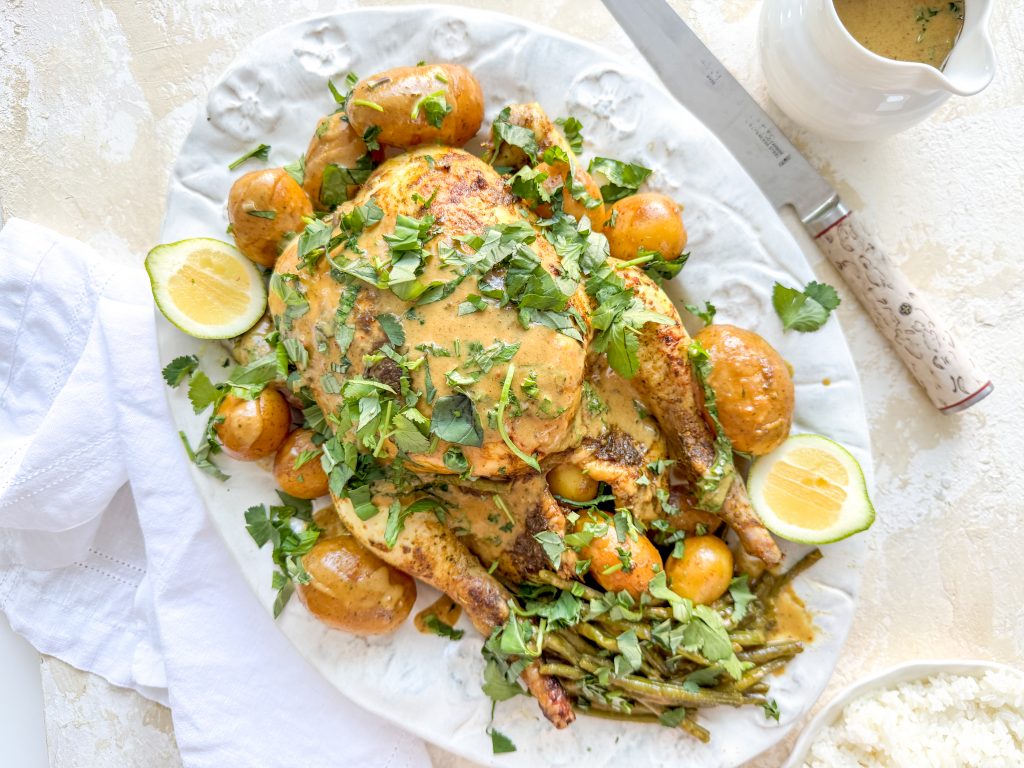
One-pot Thai Roast Chicken, New Potatoes and Green Beans with a Red Curry and Peanut Gravy
This wonderful one-pot Thai roast chicken recipe is the lovechild of Thai Red Chicken Curry and Satay Chicken with Peanut Sauce; two of our absolute favourite suppers. If you are looking for tender, melt-in-mouth roast chicken with Thai flavours, a significant kick, cooked in one-pot with vegetables and a thick, rich spicy gravy, this dish will really, hit the spot.
Serves 3 – 4
Ingredients
Chicken:
- 1.5 – 2kg whole chicken
- 3 plump cloves of garlic, bashed. No need to peel.
- 2 kaffir lime leaves
- 1 stalk of lemon grass, trimmed, cut into 3 or 4 pieces and bashed
- few sprigs of fresh coriander
- few sprigs of fresh Thai basil, if you can find some. If not, simply omit.
- 1 tablespoon coconut oil, or use any neutral oil.
- 400g new potatoes. Skin on and halved or cut into 3 or 4 pieces, if large.
- 200ml chicken stock. Either homemade or shop bought.
- 200g green beans, trimmed
Marinade:
- 5g fresh coriander, including stalks
- 5g fresh Thai basil, including stalks
- 16g/4 plump cloves of garlic, peeled
- 1 tablespoon Thai red curry paste, either homemade or shop bought.
- 1 tablespoon curry powder
- 15g/1 tablespoon palm sugar (or coconut, soft brown or caster sugar)
- 1 tablespoon fish sauce
- 4 tablespoons good quality coconut milk from a 400ml can. Save the rest of the can to use on the sauce.
Sauce:
- remainder of 400g can of coconut milk (from above)
- 40g/2 tablespoons Thai red curry paste, either homemade or shop bought.
- 40g smooth peanut butter, ideally natural
- 15g/1 tablespoon palm sugar (or coconut, soft brown or caster sugar)
- 1½ tablespoons fish sauce
- 4 kaffir lime leaves
- 15g – 20g Thai sweet basil leaves, roughly shredded
Serve:
- 2 limes, in wedges
- fresh coriander and/or Thai basil to garnish
- steamed rice. Ideally Jasmine, but just use your favourite
Instructions
-
Collect together your equipment (see Recipe Notes below) and ingredients. You will also need a deep sided roasting tin, which you can also use on the hob.
-
Bring the chicken to room temperature. This will take between 30 minutes to an hour, depending on the ambient temperature.
-
Preheat oven to 170°C/325°F/Gas 3 (fan 150°C).
-
Marinade paste – blitz all the ingredients in a mini food processor until you have formed a paste.
-
Prepare and cook the chicken – lightly oil the base of the deep sided roasting tin with coconut oil.
-
Stuff the garlic, lime leaves, bashed lemon grass, coriander and Thai basil inside the cavity of the chicken, and place into the tin.
-
Rub the paste all over the outside of the chicken thoroughly, ensuring it is well coated and in all the nooks and crannies.
-
Halve or quarter any large potatoes, scatter around the chicken and then pour in the chicken stock.
-
Cover with kitchen foil and cook in the centre of a pre-heated oven for 1 hour.
-
Remove from the oven and turn the heat up to 220°C/425°F/Gas 7 (fan 200°C).
-
Remove the foil, baste the chicken and add the trimmed green beans. Return to the oven, uncovered, and continue to cook for 20 – 40 minutes, or until the chicken is cooked. To check if it is cooked, pull the leg away from the bird slightly and skewer into the breast flesh behind the leg. Any juices coming out of the bird should be clear and the meat should be opaque. If you see any pinkness or blood, cook for a further 10 – 15 minutes, or until cooked. If you use a meat thermometer, the internal temperature of the meat should read 75°C or 165°F.
-
Make the red curry gravy – remove the chicken from the pan, scraping any thick areas of paste on the chicken into the pan. Allow the chicken to rest for 10 – 15 minutes before serving.
-
Meanwhile, add the coconut milk to the pan with the curry paste, peanut butter, palm sugar, fish sauce and kaffir lime leaves. Bring to a gentle simmer for 10 minutes to thicken and allow the flavours to develop and merge. Stir regularly.
-
Add any juices from the resting chicken and finally stir in the fresh herbs. Taste and adjust seasoning, if necessary.
-
Serve: garnish the roast chicken, potatoes and beans with some of the red curry gravy, scatter with some chopped fresh herbs and serve with the remaining gravy. I also serve it with some steamed rice and lime wedges on the side.
Recipe Notes
Equipment:
- kitchen scales and measuring spoons
- chopping board and knife
- food processor
- deep sided roasting tin/baking dish you can use in the oven and on the hob
Why should meat be at room temperature when cooked?
When you cook meat, the muscles in the flesh contract and tighten when heated. The colder the muscles the more they will contract; this means it is harder for the heat to distribute evenly. By letting the meat come to room temperature before you cook it, the meat will cook more evenly and when cooked, it will be juicier. It can take between 30 – 60 minutes for fridge cold meat to reach room temperature, depending on its size and the ambient room temperature.
Why do you need time to rest the meat after cooking?
As the muscles of the meat contract and tighten when cooked, the juices are forced toward the surface of the meat and some will evaporate. (Which is why overcooked meat is dry.) Allowing the meat to rest after you have removed the heat source, means the muscles will relax and the juices can re-distribute throughout the meat. If you cut it immediately, you are in danger of losing some of these juices; your chicken may then be dry and the flavour from those gorgeous juices will be lost.
You May Also Like
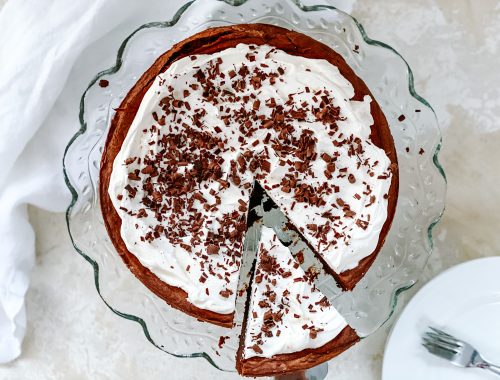
Flourless Chocolate Cake
15th July 2021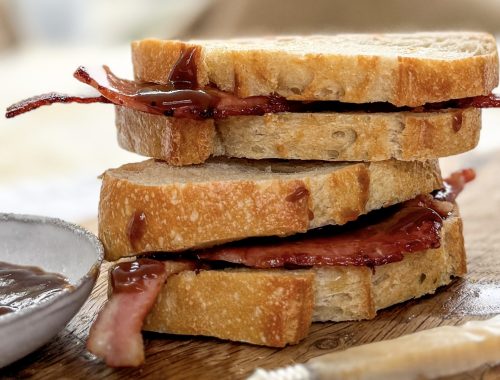
Bacon Sandwich
26th September 2025